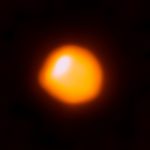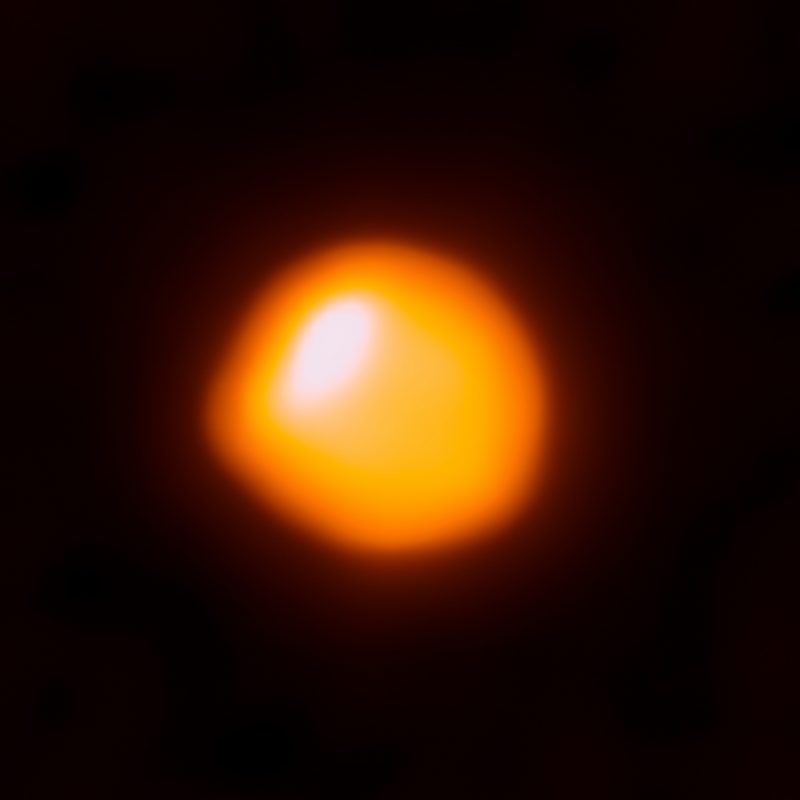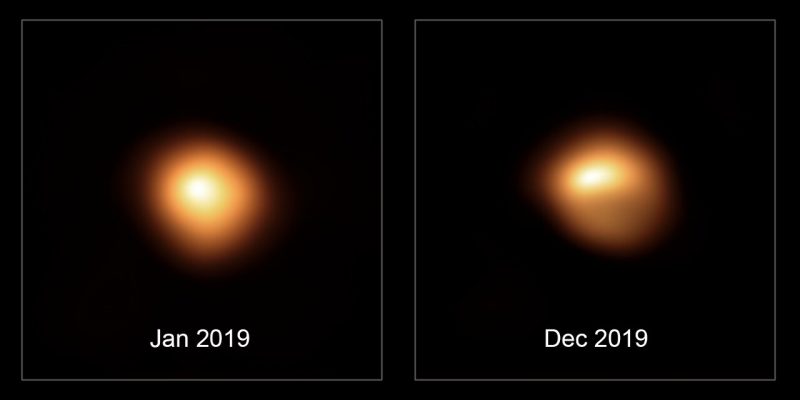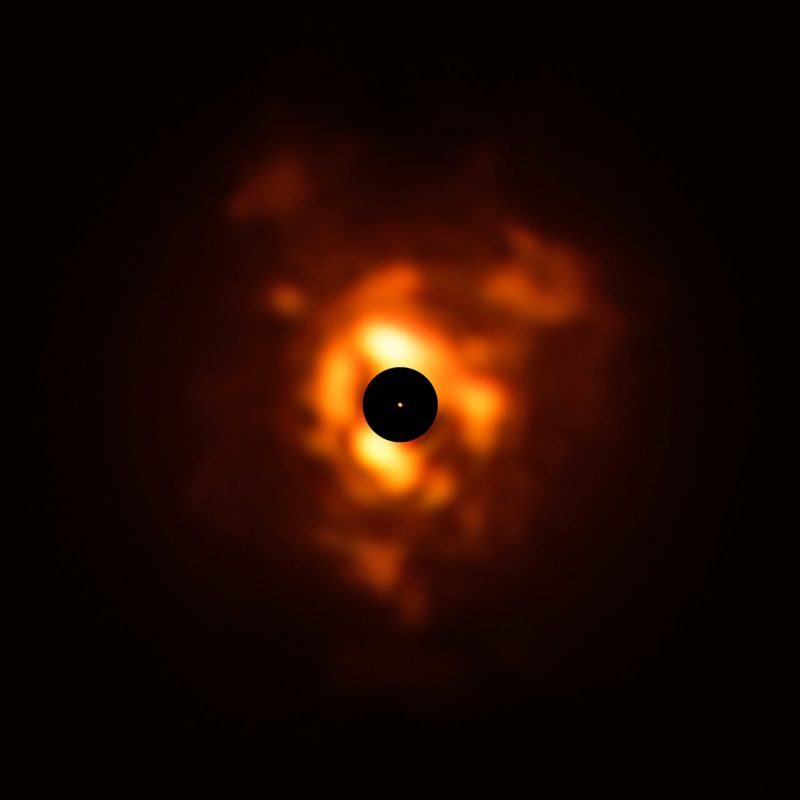

Betelgeuse as seen in sub-millimeter wavelengths by the ALMA telescope in Chile. The “bump” on the left side is hot gas slightly protruding from the red supergiant star’s extended atmosphere. Image via ALMA (ESO/ NAOJ/ NRAO)/ E. O’Gorman/ P. Kervella/ ASU.
Betelgeuse is a red supergiant star in the famous constellation Orion the Hunter and one of the brightest stars in our night sky. Last year, this beloved bright star began dimming dramatically, which prompted speculation as to whether it might finally be nearing its end in a fiery explosion – a supernova – as is expected to happen sometime in the future. Many asked, could this be it? It was very exciting. But now a new study from researchers at Australian National University – announced on October 16, 2020 – suggests we might have to wait another 100,000 years before Betelgeuse’s explosive finale. The findings also show that Betelgeuse is smaller and closer than scientists had thought.
The 2021 lunar calendars are here! Order yours before they’re gone. Makes a great gift!
The researchers published their conclusions in a new peer-reviewed paper in The Astrophysical Journal on October 13, 2020.

This comparison image shows the star Betelgeuse before and after its unprecedented dimming, which started in late 2019. The observations – taken with the SPHERE instrument of the Very Large Telescope (VLT) in January and December 2019 – show how much the star faded and how its apparent shape changed. Image via ESO/ M. Montargès et al.
Meridith Joyce at ANU, who led the study, stated:
It’s normally one of the brightest stars in the sky, but we’ve observed two drops in the brightness of Betelgeuse since late 2019. This prompted speculation it could be about to explode. But our study offers a different explanation. We know the first dimming event involved a dust cloud. We found the second smaller event was likely due to the pulsations of the star.
If indeed the second dimming of the star was due to natural pulsations, that would be significant in terms of what will happen to Betelgeuse in the near and long-term future. Using hydrodynamic and seismic modeling, the researchers were able to determine that pressure waves were the cause of the pulsations. This means that the star is still burning helium, and therefore it shouldn’t explode anytime soon. Co-author Shing-Chi Leung from the University of Tokyo said the study:
… confirmed that pressure waves – essentially, sound waves – were the cause of Betelgeuse’s pulsation.

This image, obtained with the VISIR instrument on ESO’s Very Large Telescope, shows the infrared light being emitted by the dust surrounding Betelgeuse in December 2019. The clouds of dust, which resemble flames in this dramatic image, are formed when the star sheds its material back into space. The black disk obscures the star’s center and much of its surroundings, which are very bright and must be masked to allow the fainter dust plumes to be seen. The orange dot in the middle is the SPHERE image of Betelgeuse’s surface, which has a size close to that of Jupiter’s orbit. Image via ESO/ P. Kervella/ M. Montargès et al.
Joyce added:
It’s burning helium in its core at the moment, which means it’s nowhere near exploding. We could be looking at around 100,000 years before an explosion happens.
The study also provided other surprising details about Betelgeuse: it’s smaller and closer to our solar system than previously thought. It’s still a red supergiant star, hundreds of times larger than our sun, but with a slightly smaller radius. According to co-author László Molnár from the Konkoly Observatory in Budapest:
The actual physical size of Betelgeuse has been a bit of a mystery; earlier studies suggested it could be bigger than the orbit of Jupiter. Our results say Betelgeuse only extends out to 2/3 of that, with a radius 750 times the radius of the sun.
Once we had the physical size of the star, we were able to determine the distance from Earth. Our results show it’s a mere 530 light-years from us, 25% closer than previous thought.

Meridith Joyce at ANU, lead author of the new study. Image via ANU.
That’s significantly closer than the previously estimated distance of 724 light-years, but still plenty far away safety-wise. Whenever Betelgeuse does eventually explode, it is still distant enough that the explosion won’t have much, if any, effect on Earth. That’s a comforting thought, although if the scientists are right, none of us alive right now will be around to see it. But for any other scientists at the time, it will be a unique chance to witness a supernova that is relatively close by. Joyce said:
It’s still a really big deal when a supernova goes off. And this is our closest candidate. It gives us a rare opportunity to study what happens to stars like this before they explode.
Last August, scientists using the Hubble Space Telescope (HST) reported that a large cloud of dust most likely caused the star’s first major dimming, starting in late 2019. The dust cloud is thought to have formed from dense hot gas moving through Betelgeuse’s extended atmosphere.

This 3-paneled artist’s concept illustrates new research, explaining why the bright red supergiant star Betelgeuse suddenly became fainter for several months during late 2019 and early 2020. In panel 1, a bright, hot blob of plasma is ejected from the star. In panel 2, outflowing expelled gas rapidly expands outward and cools to form an enormous cloud of obscuring dust. In panel 3, the huge dust cloud partially blocks Betelgeuse’s light. Image via NASA/ ESA/ E. Wheatley (STScI)/ CfA.
The star later started returning to normal brightness until between late June and early August 2020, when it began dimming once again. As explained in this new study, the second, shallower dimming was likely caused by normal pulsations in the star itself. This isn’t too surprising, since Betelgeuse is a variable star and goes through brightness cycles that last about 420 days.
The new results support other assertions from scientists that Betelgeuse most likely won’t go supernova anytime soon. Plus, having more accurate measurements of the star’s size and distance will help researchers better understand its behavior and how and why these giant stars eventually face such fiery deaths.
Bottom line: The red supergiant star Betelgeuse may not explode for another 100,000 years, and is also smaller and closer than first thought, according to a new study.
Via Australian National University
from EarthSky https://ift.tt/3mf98iJ


Betelgeuse as seen in sub-millimeter wavelengths by the ALMA telescope in Chile. The “bump” on the left side is hot gas slightly protruding from the red supergiant star’s extended atmosphere. Image via ALMA (ESO/ NAOJ/ NRAO)/ E. O’Gorman/ P. Kervella/ ASU.
Betelgeuse is a red supergiant star in the famous constellation Orion the Hunter and one of the brightest stars in our night sky. Last year, this beloved bright star began dimming dramatically, which prompted speculation as to whether it might finally be nearing its end in a fiery explosion – a supernova – as is expected to happen sometime in the future. Many asked, could this be it? It was very exciting. But now a new study from researchers at Australian National University – announced on October 16, 2020 – suggests we might have to wait another 100,000 years before Betelgeuse’s explosive finale. The findings also show that Betelgeuse is smaller and closer than scientists had thought.
The 2021 lunar calendars are here! Order yours before they’re gone. Makes a great gift!
The researchers published their conclusions in a new peer-reviewed paper in The Astrophysical Journal on October 13, 2020.

This comparison image shows the star Betelgeuse before and after its unprecedented dimming, which started in late 2019. The observations – taken with the SPHERE instrument of the Very Large Telescope (VLT) in January and December 2019 – show how much the star faded and how its apparent shape changed. Image via ESO/ M. Montargès et al.
Meridith Joyce at ANU, who led the study, stated:
It’s normally one of the brightest stars in the sky, but we’ve observed two drops in the brightness of Betelgeuse since late 2019. This prompted speculation it could be about to explode. But our study offers a different explanation. We know the first dimming event involved a dust cloud. We found the second smaller event was likely due to the pulsations of the star.
If indeed the second dimming of the star was due to natural pulsations, that would be significant in terms of what will happen to Betelgeuse in the near and long-term future. Using hydrodynamic and seismic modeling, the researchers were able to determine that pressure waves were the cause of the pulsations. This means that the star is still burning helium, and therefore it shouldn’t explode anytime soon. Co-author Shing-Chi Leung from the University of Tokyo said the study:
… confirmed that pressure waves – essentially, sound waves – were the cause of Betelgeuse’s pulsation.

This image, obtained with the VISIR instrument on ESO’s Very Large Telescope, shows the infrared light being emitted by the dust surrounding Betelgeuse in December 2019. The clouds of dust, which resemble flames in this dramatic image, are formed when the star sheds its material back into space. The black disk obscures the star’s center and much of its surroundings, which are very bright and must be masked to allow the fainter dust plumes to be seen. The orange dot in the middle is the SPHERE image of Betelgeuse’s surface, which has a size close to that of Jupiter’s orbit. Image via ESO/ P. Kervella/ M. Montargès et al.
Joyce added:
It’s burning helium in its core at the moment, which means it’s nowhere near exploding. We could be looking at around 100,000 years before an explosion happens.
The study also provided other surprising details about Betelgeuse: it’s smaller and closer to our solar system than previously thought. It’s still a red supergiant star, hundreds of times larger than our sun, but with a slightly smaller radius. According to co-author László Molnár from the Konkoly Observatory in Budapest:
The actual physical size of Betelgeuse has been a bit of a mystery; earlier studies suggested it could be bigger than the orbit of Jupiter. Our results say Betelgeuse only extends out to 2/3 of that, with a radius 750 times the radius of the sun.
Once we had the physical size of the star, we were able to determine the distance from Earth. Our results show it’s a mere 530 light-years from us, 25% closer than previous thought.

Meridith Joyce at ANU, lead author of the new study. Image via ANU.
That’s significantly closer than the previously estimated distance of 724 light-years, but still plenty far away safety-wise. Whenever Betelgeuse does eventually explode, it is still distant enough that the explosion won’t have much, if any, effect on Earth. That’s a comforting thought, although if the scientists are right, none of us alive right now will be around to see it. But for any other scientists at the time, it will be a unique chance to witness a supernova that is relatively close by. Joyce said:
It’s still a really big deal when a supernova goes off. And this is our closest candidate. It gives us a rare opportunity to study what happens to stars like this before they explode.
Last August, scientists using the Hubble Space Telescope (HST) reported that a large cloud of dust most likely caused the star’s first major dimming, starting in late 2019. The dust cloud is thought to have formed from dense hot gas moving through Betelgeuse’s extended atmosphere.

This 3-paneled artist’s concept illustrates new research, explaining why the bright red supergiant star Betelgeuse suddenly became fainter for several months during late 2019 and early 2020. In panel 1, a bright, hot blob of plasma is ejected from the star. In panel 2, outflowing expelled gas rapidly expands outward and cools to form an enormous cloud of obscuring dust. In panel 3, the huge dust cloud partially blocks Betelgeuse’s light. Image via NASA/ ESA/ E. Wheatley (STScI)/ CfA.
The star later started returning to normal brightness until between late June and early August 2020, when it began dimming once again. As explained in this new study, the second, shallower dimming was likely caused by normal pulsations in the star itself. This isn’t too surprising, since Betelgeuse is a variable star and goes through brightness cycles that last about 420 days.
The new results support other assertions from scientists that Betelgeuse most likely won’t go supernova anytime soon. Plus, having more accurate measurements of the star’s size and distance will help researchers better understand its behavior and how and why these giant stars eventually face such fiery deaths.
Bottom line: The red supergiant star Betelgeuse may not explode for another 100,000 years, and is also smaller and closer than first thought, according to a new study.
Via Australian National University
from EarthSky https://ift.tt/3mf98iJ

Aucun commentaire:
Enregistrer un commentaire